|
Having trouble reading this email? Download the PDF. 
Thematic focus: Ecosystem management, Environmental governance, Harmful substances and hazardous wasteMunicipal solid waste: Is it garbage or gold?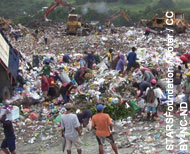
Waste management has become an issue of growing global concern as urban populations continue to increase and consumption patterns change. The health and environmental implications associated with garbage disposal are mounting in urgency, particularly in developing countries. However, the growth of the solid-waste market, increasing resource scarcity and the availability of new technologies are offering opportunities for turning waste into a resource. Why is this issue important?Urbanization has increased in speed and scale in recent decades, with more than half the world's population now living in urban centres (Tacoli, 2012; UNPD, 2012a) (see Figure 1). By 2050, urban dwellers probably will account for 86 per cent of the population in developed countries and for 64 per cent of the population in developing countries (UNPD, 2012a). Rapid urban population growth has resulted in a number of land-use and infrastructural challenges, including municipal solid-waste management. National and municipal governments often have insufficient capacity or funding to meet the growing demand for solid-waste management services (Tacoli, 2012). Solid-waste management is the single largest budget item for many cities (World Bank, 2012; UN-HABITAT, 2010). 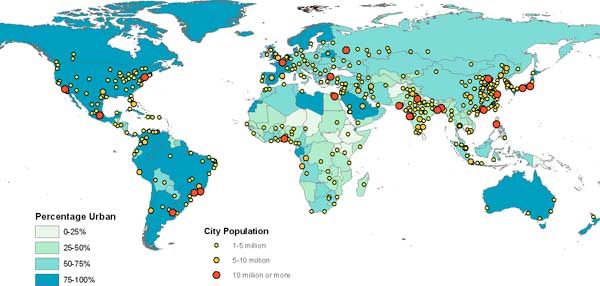
Figure 1: Percentage of urban population and agglomerations by size class, 2011 (UNPD, 2012b). The waste sector traditionally refers to municipal solid waste and excludes wastewater, which tends to be categorised under the water or industry sectors. The scope of this bulletin is therefore limited to municipal solid waste (MSW). Municipal solid waste is generally composed of electrical and electronic equipment (such as discarded computers, printers, mobile phones, TVs and refrigerators), construction and demolition waste, health-care waste, and waste from households, offices, shops, schools and industries, and agricultural residues. These include food waste, garden (yard) and park waste, paper and cardboard, wood, textiles, nappies (disposable diapers), rubber and leather, plastics, metal, glass (and pottery and china) and refuse such as ash, dirt, dust, soil and electronic waste (Guerrero et al., 2013; IPCC, 2007). The content of MSW differs between developing and developed countries, and even between regions or cities in countries. For example, MSW in developing countries has a much larger proportion of organic waste than in developed countries (World Bank, 2012). Electronic waste constitutes a major source of new and complex hazardous garbage to the environment and human health and presents a growing challenge to both developed and developing countries (UNEP and UNU, 2009). There are concerns over medical consequences from landfill sites and older incinerators, including cancer, mortality, birth defects and low birth weight (WHO, 2007). Ozone-depleting substances released from discarded electronic appliances and building materials (e.g. foams), as well as industrial waste practices, contribute to ozone-layer depletion (UNEP, 2011). 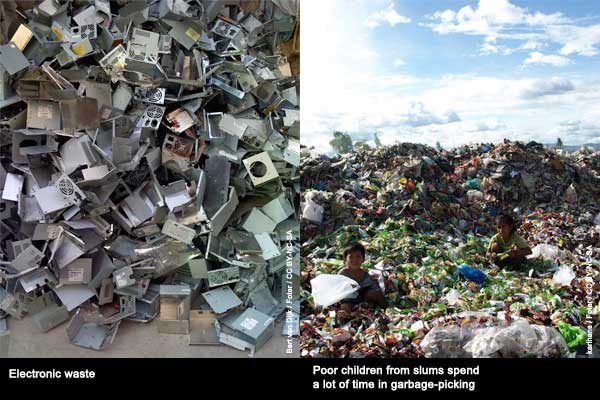
In developing countries, open dumpsites are the most common method of disposing of waste (World Bank 2012). Dumping of mixed waste occurs alongside open burning, grazing of stray animals and pollution of surface and groundwater by hazardous substances such as leachate and gas (UNEP, 2011). Dumpsites have been linked to many harmful health effects, including skin and eye infections, respiratory problems, vector-borne diseases such as diarrhoea, dysentery, typhoid, hepatitis, cholera, malaria and yellow fever, high blood lead levels and exposure to heavy-metal poisoning (UNEP, 2011). However, in developing countries, data on waste generation and composition are largely unreliable and insufficient, seldom capturing system losses or informal activities (Jha et al., 2011; UN-HABITAT, 2010). Without proper data it might be difficult to design sound strategies or to make wise budget decisions on waste management (Wilson et al., 2012). This bulletin provides examples from Europe, where considerable progress has been made toward solutions for waste management. Landfill sites continue to represent one of the most serious environmental threats in several European countries (Raco et al., 2013). Cities such as Naples in Italy have experienced extended waste-management crises (Mazzanti et al., 2012). However, new communication tools and technology options such as waste-to-energy (or energy from waste) offer possible strategies forward. What are the findings?The waste hierarchy is now used globally as a communication tool to remind those who generate waste and those who manage it that preventing waste through efficient use of resources and raw materials is the best option. Re-using discarded goods without reprocessing or remanufacture is assumed to provide greater savings in resource consumption and is given priority over recycling (Figure 2) (Wolsink, 2010). 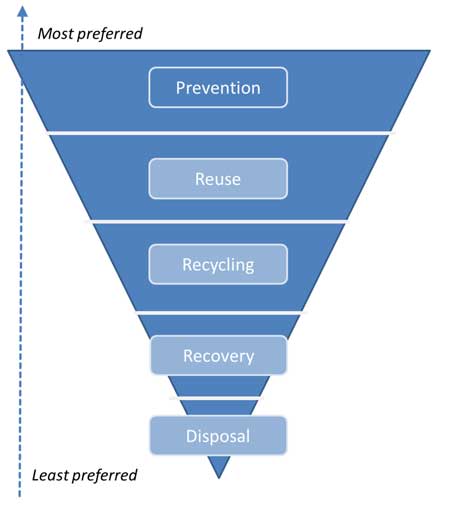
Figure 2: Waste management hierarchy (UNEP, 2011). Increased scarcity of natural resources and the consequent rise in commodity prices have influenced the demand for recycled products. The resource value of waste has become an important driver in many developing countries today and provides a livelihood for the urban poor (UN-HABITAT, 2010). Recycling materials such as paper, glass and plastics, as well as composting and digestion of bio-waste, becomes the obvious next preferable option. Aerobic (with oxygen) composting of MSW avoids the formation of methane associated with anaerobic conditions. The method is generally less complex and less costly (World Bank, 2012). The world market for municipal waste, from collection to recycling, is worth an estimated US $410 billion a year (Chalmin and Gaillochet, 2009). However, only a quarter of the 4 billion tonnes of municipal waste produced each year is recycled or recovered (Chalmin and Gaillochet, 2009). Figure 3 shows the recycling rates of MSW in the European Union in 2010 compared with 2001. A line further from the centre in the radar chart signifies better waste management. As the figure indicates, recycling performance has improved in most European countries. In a report assessing recycling's economic implications, recycling had a turnover of EUR 32 billion in 2004, and increased by almost 100 per cent to a minimum of EUR 60 billion in 2008 in the European Union countries (EEA, 2011). From 2000 to 2008, employment growth in the recycling sector increased 7 per cent each year, with an overall increase of 45 per cent. Recycling generated more jobs at higher income levels than other forms of waste management in European countries (EEA, 2011). The general increase in recycling of municipal waste reduced the percentage of municipal waste landfilled (EEA, 2013). 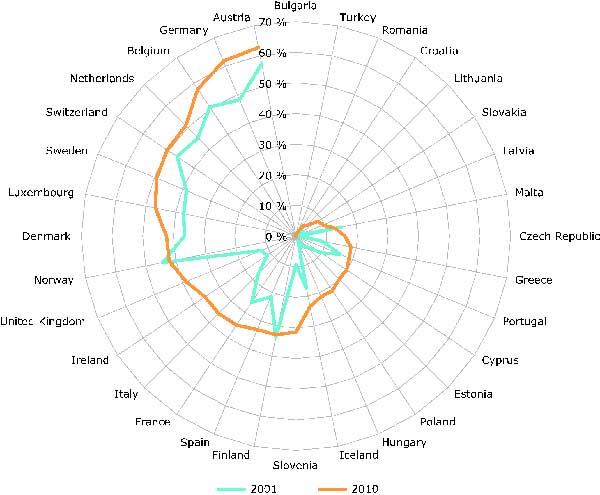
Figure 3: Municipal waste recycling rates in 32 European countries, 2001 and 2010 (EEA, 2013). The U.S. recycling industry is estimated to have earned US $236 billion in revenue in 2007, employing more than a million people and accounting for about 2 per cent of the country's GDP (EPN, 2009). Another estimate suggests that about 1 per cent of the urban population in developing countries is engaged in waste collection for their livelihood (Medina, 2008). New energy recovery technologies Where waste cannot be reused or recycled due to technical, economic and environmental considerations, recovering value from waste is being promoted. Incineration alone, without energy recovery, is not a preferred option because of costs and pollution. Open-burning of waste is particularly discouraged because of the severe air pollution associated with low- temperature combustion (World Bank, 2012). As a result, there has been renewed interest in investing in waste-management technologies for extracting energy from organic waste (Papageorgiou et al., 2009; Marshall and Farahbakhsh, 2013) and efficient gas capture from landfills (UNEP, 2011). Energy from waste techniques (sometimes referred to as waste to energy, WtE) has replaced mass-burning of organic waste without energy recovery in many of the countries of the Organisation for Economic Cooperation and Development (UNEP, 2011). The process generates energy, usually in the form of electricity or heat, from controlled thermal treatment of a waste. Anaerobic digestion is considered to be one of the most viable options for recycling the organic fraction of solid waste with substantial amounts of methane (biogas) (Khalid et al., 2011). The technique involves microorganisms in an enclosed vessel that break down biodegradable material in the absence of oxygen. Biogas produced can be used to generate electricity and heat, and can be used as a substitute for natural gas and transportation fuel. The digested slurry can be further processed into compost and liquid fertilizer (Khalid et al., 2011). Unlike fossil fuel, biogas does not contribute much to the greenhouse effect, ozone depletion or acid rain. This is one of the main reasons that anaerobic digestion might play a crucial role in meeting energy challenges of the future generation (Ward et al., 2008; Khalid et al., 2011). The technique has been recognised as suitable for processing organic wet waste in developing countries (UNEP, 2011). Incineration of waste (with energy recovery) is the most common thermal treatment of waste and can reduce the volume of disposed waste by up to 90 per cent (World Bank, 2012). The gases from the thermal step are used to boil water to create steam. This is then fed into a steam turbine to generate electricity and/or used for heating (DEFRA, 2013). Incineration is expensive in terms of capital and operating costs, and requires high standards of operation and maintenance. In many developing countries, MSW generally has a low energy value because of its high moisture content and the prior removal of paper and plastic by waste pickers. Incineration of such waste will require additional fuel (usually oil) in order to keep the wastes burning (UN-HABITAT, 2010). The advanced thermal treatment of waste includes such technologies as pyrolysis and gasification. Pyrolysis leads to the chemical decomposition of organic material at elevated temperatures of 430°C in the absence of oxygen (DEFRA, 2013). The main product — syngas — can be used as a fuel to generate electricity or steam or as a basic chemical feedstock in the petrochemical and refining industries (FOE, 2009). Gasification uses very high temperatures that convert organic materials at controlled amounts of oxygen into carbon monoxide, hydrogen, carbon dioxide and methane (Arena, 2011). Hydrogen is high in energy and an engine that burns pure hydrogen produces almost no pollution. However, the technologies are technically difficult, relatively unproven at commercial scale, and some of the generated energy is used to power the process and hence reduces the overall benefits (DEFRA, 2013; Arena, 2011; FOE, 2009). A number of thermal-based energy recovery processes have been reported, mainly in Europe, the United States, Japan, China and South Korea (ISWA, 2013). WtE in Europe already supplies a considerable amount of renewable energy (some 38 billion kilowatt-hours in 2006). By 2020, the amount might grow to as much as 98 billion kilowatt-hours, enough to supply 22.9 million inhabitants with electricity and 12.1 million inhabitants with heat (CEWEP, 2009). By 2009, USA had 88 WtE plants that combust about 26.3 million tonnes of MSW and serve a population of 30 million (Psomopoulos et al., 2009). Interestingly, the communities that use WtE in the U.S. have a 17.8 per cent higher recycling rate than the U.S. EPA average, showing that energy from waste coexists with high recycling (Psomopoulos et al., 2009). What are the implications for policy?Managing waste is a complex task that requires changes in consumption and waste production patterns, appropriate technology, organizational capacity, and co-operation among a wide range of stakeholders (Zarate et al., 2008). Data on waste management should be collected, although complete and reliable data are extremely difficult to obtain (Wilson et al., 2012). Municipal and national governments can help fill data gaps by developing waste data strategies, as produced by the Scottish Environment Protection Agency, and by ensuring statutory reporting requirements are met. Research institutions and universities have a role to play — finding cleaner, greener ways to process waste and discovering viable ways to extract energy from waste. There is also an on-going need to develop municipal and national waste-management plans. A democratic, public process of formulating MSW goals is essential to determine the actual needs of citizens, and so to be able to prioritize limited municipal resources in a just manner (Marshall and Farahbakhsh, 2013). Waste management solutions in one region might not be appropriate elsewhere. For example, some WtE techniques might be more appropriate in developed or middle-income countries, while in developing countries, composting organic waste and biogas capture may be more useful to deal with waste high in organic matter. Large-scale investment in a specific technology, such as WtE, might also lead to technological "lock-in," narrowing options in the future. The waste hierarchy can be used to identify the most resource-efficient, long-term approach to waste management. Guidelines also exist for how to generate national waste management strategies (UNEP and UNITAR, 2013). Ultimately, waste management presents an opportunity, not only to avoid the detrimental impacts associated with waste, but also to recover resources, realise environmental, economic and social benefits and to take a step on the road to a sustainable future. Decision makers, responsible for planning and policy making, need to be well informed in order to develop integrated waste-management strategies adapted to the needs of citizens (Guerrero et al., 2013). When informed decisions about waste management are made and applied to the circumstances that prevail, waste can even provide economic value. MSW management has not always been a high priority for local and national policy makers and planners, especially in developing countries. Other issues with more social and political urgency might take precedence and leave little budget for waste issues (Memon, 2010). Thus, in many cities around the world, effective, functioning policy measures have been elusive and the resources invested in the sector inadequate (Konteh, 2009). National governments can make a critical contribution by making waste management a national priority. They can also ensure the availability of skills, knowledge, and capacity to implement waste management programs effectively, especially at the local level, helping turn garbage to "gold." AcknowledgementWriter: A. Rozenberga
ReferencesArena, U., 2011. Process and technological aspects of municipal solid waste gasification. A review. Waste Management 32(4), 625–639. CEWEP, 2009. Position paper on sustainable energy from waste. Confederation of European Waste-to- Energy Plants (CEWEP), Brussels. http://www.cewep.eu/m_431 (accessed 24.10.13). Chalmin, P. and Gaillochet, C., 2009. From waste to resource, An abstract of world waste survey. Cyclope, Veolia Environmental Services, Edition Economica, France. DEFRA, 2013. Energy from Waste: A guide to the debate. Department for Environment, Food and Rural Affairs, UK. http://www.defra.gov.uk/publications/2013/02/27/pb13892-energy-from-waste/ (accessed 23.10.13). EEA, 2011. Earnings, jobs and innovation: the role of recycling in a green economy. European Environment Agency, Copenhagen. http://www.eea.europa.eu/publications/earnings-jobs-and-innovation-the (accessed 10.10.13). EEA, 2013. Managing municipal solid waste – a review of achievements in 32 European countries. European Environment Agency, Copenhagen. http://www.eea.europa.eu/publications/managing-municipal-solid-waste (accessed 10.10.13). EPN, 2009. Opportunities for Economic Growth and Carbon Emissions Reduction in the U.S. Pulp and Paper Industry. Environment Paper Network. http://www.environmentalpaper.org/ (Accessed 27.09.13). FOE, 2009. Briefing - Pyrolysis, gasification and plasma. Friends of the Earth. http://www.foe.co.uk/resource/briefings/gasification_pyrolysis.pdf (accessed 23.10.13). Guerrero, L., Maas, G., Hogland, W., 2013. Solid waste management challenges for cities in developing countries. Waste Management 33(1), 220–232. IPCC, 2007. Climate Change 2007: Mitigation. Contribution of Working Group III to the Fourth Assessment Report of the Intergovernmental Panel on Climate Change. Chapter 10 — Waste management. J. Bogner, Coordinating Lead Author. B. Metz, O.R. Davidson, P.R. Bosch, R. Dave, L.A. Meyer (eds). Cambridge University Press. ISWA, 2013. White Paper: Alternative waste conversion technologies. International Solid Waste Association. http://www.iswa.org/ (accessed 10.10.13). Jha, A., Singh, G., Gupta P., 2011. Sustainable municipal solid waste management in low income group of cities: a review. Tropical Ecology 52, 123-131. Khalid, A., Arshad, M., Anjum, M., Mahmood, T., Dawson, L., 2011. The anaerobic digestion of solid organic waste. Waste Management 31(8), 1737–1744. Konteh, F., 2009. Urban sanitation and health in the developing world: reminiscing the nineteenth century industrial nations. Health & Place 15, 69–78. Marshall, R. and Farahbakhsh, K., 2013. Systems approaches to integrated solid waste management in developing countries. Waste Management 33(4), 988-1003. Mazzanti, M., Montini, A., Nicolli, F., 2012. Waste dynamics in economic and policy transitions: decoupling, convergence and spatial effects. Journal of Environmental Planning and Management 55, 563-581. Medina, M., 2008. The informal recycling sector in developing countries - Organizing waste pickers to enhance their impact. Note No.44. October 2008, GRIDlines. https://www.ppiaf.org/ (accessed 22.10.2013). Memon, M., 2010. Integrated solid waste management based on the 3R approach. Journal of Material Cycles and Waste Management 12, 30–40. Papageorgiou, A., Barton, J., Karagiannidis, A., 2009. Assessment of the greenhouse effect impact of technologies used for energy recovery from municipal waste: A case for England. Journal of Environmental Management 90, 2999–3012. Psomopoulos, C., Bourka, A., Themelis, N., 2009. Waste-to-energy: a review of the status and benefits in USA. Waste Management 29, 1718–1724. Raco, B., Dotsika, E., Battaglini, R., Bulleri, E., Doveri, M., Papakostantinou, K., 2013. A quick and reliable method to detect and quantify contamination from MSW landfills: a case study. Water Air and Soil Pollution 224(1380), doi: 10.1007/s11270-012-1380-5 Tacoli, C., 2012. Urbanization, Gender and Urban Poverty: Paid Work and Unpaid Carework in the City. International Institute for Environment and Development: United Nations Population Fund, London, UK. UNEP, 2011. Towards a Green Economy: Pathways to Sustainable Development and Poverty Eradication, United Nations Environment Programme (UNEP). UNEP and UNITAR, 2013. Guidelines for National Waste Management Strategies: Moving from Challenges to Opportunities. United Nations Environment Programme (UNEP) and United Nations Institute for Training and Research (UNITAR), http://www.unep.org/ietc/Portals/136/Publications/Waste%20Management/UNEP%20NWMS%20English.pdf (accessed 28.10.13). UNEP and UNU, 2009. Recycling- from e-waste to resources. Sustainable innovation and technology transfer industrial sector studies. United Nations Environment Programme & United Nations University. UN-HABITAT, 2010. Collection of Municipal Solid Waste in Developing Countries. United Nations Human Settlements Programme (UN-HABITAT), Nairobi. UNPD, 2012a. World Urbanization Prospects, the 2011 Revision. Department of Economic and Social Affairs, Population Division, United Nations, New York. http://esa.un.org/unup/pdf/WUP2011_Highlights.pdf (accessed 09.10.13). UNPD, 2012b. World Urbanization Prospects, the 2011 Revision. Department of Economic and Social Affairs, Population Division, United Nations, New York. http://esa.un.org/unup/Maps/maps_urban_2011.htm (accessed 09.10.13). Ward, A., Hobbs, P., Holliman, P., Jones, D., 2008. Optimization of the anaerobic digestion of agricultural resources. Bioresour. Technol. 99, 7928–7940. WHO, 2007. Population health and waste management — Scientific data and policy options. Report of WHO workshop, Rome, Italy, 29-30 March 2007. Available at: http://www.euro.who.int/__data/assets/pdf_file/0012/91101/E91021.pdf (accessed 23.10.13). Wilson, D., Rodic, L., Scheinberg, A., Velis, C. and Alabaster, G., 2012. Comparative analysis of solid waste management in 20 cities. Waste Management & Research 30, 237-254. Wolsink, M., 2010. Contested environmental policy infrastructure: socio-political acceptance of renewable energy, water, and waste facilities. Environmental Impact Assessment Review 30, 302010. World Bank, 2012. What a Waste: A Global Review of Solid Waste Management. Urban Development Series Knowledge Papers. http://documents.worldbank.org/curated/en/2012/03/16537275/waste-global-review-solid-waste-management (accessed 09.10.13). Zarate, M., Slotnick, J., Ramos, M., 2008. Capacity building in rural Guatemala by implementing a solid waste management program. Waste Management 28(12), 2542-2551.
If you no longer wish to receive this bulletin you can unsubscribe anytime. Information is regularly scanned, screened, filtered, carefully edited, and published for educational purposes. UNEP does not accept any liability or responsibility for the accuracy, completeness, or any other quality of information and data published or linked to the site. Please read our privacy policy and disclaimer for further information. |